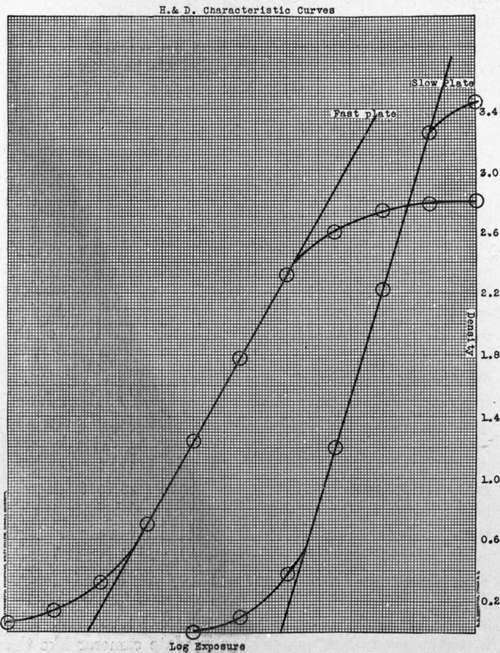Criteria Of Speed
Description
This section is from the book "Airplane Photography", by Herbert E. Ives. Also available from Amazon: Airplane photography.
Criteria Of Speed
In airplane photography speed is of paramount importance, but great care must be exercised to insure that all the factors are considered which can contribute toward yielding the desirable pictorial quality in the brief exposure which alone is possible from the moving plane. A "fast" plate on the H & D scale is not necessarily suitable for aerial work, when we remember that accentuation of natural contrast is desirable, particularly under hazy conditions. For, as is shown in Fig. 104, it is a common characteristic of "fast" plates to have comparatively small latitude and low contrast at their maximum development.
It is to be noted that the Hurter and Driffield measure of speed is bound up with the idea of correct tone rendering and with the use of the straight line portion of the characteristic curve. Other criteria of speed exist. For instance, the exposure necessary to produce a just noticeable action (threshold value); and the exposure necessary to give a chosen useful density in the high-lights when development is pushed to the limit set by the growth of fog.
As has already been pointed out, correct tone rendering is not necessary or even indicated as desirable in aerial views. It is, moreover, a matter of experience that the majority of aerial exposures with existing plates fall in the "under exposure " period, where contrasts with normal development are less than in the subject. This being the case, the problem is to select not necessarily a fast plate, by the H & D criterion, but a plate which will develop up workable densities in the under exposure region. A plate of medium speed will sometimes develop to greater densities in the short exposure region, if development is forced, than will a fast plate. The contrast in the normal exposure region will be excessive, but this is of no significance if no exposure falling in this region is present on the plate.

Fig. 104. - Characteristic curves of fast and slow plates, developed to maximum contrast.
In addition to its capacity for developing density, the ■ plate should have as low a threshold as possible, thus meeting to some extent the requirements of both the alternative criteria of speed given above. At the same time it is true that low threshold and good density for short exposures are not to be found in really slow plates. Consequently, while high speed, as ordinarily understood, is undoubtedly the first requirement, we may expect the complete specification for the best aerial plate to be a rather complicated thing, describing the characteristics of a workable "toe" of the curve, in terms of which several (e.g., contrast and speed) are derived from another and quite different exposure region.
Continue to:
Tags
camera, lens, airplane, aerial, film, exposure, photography, maps, birdseye
